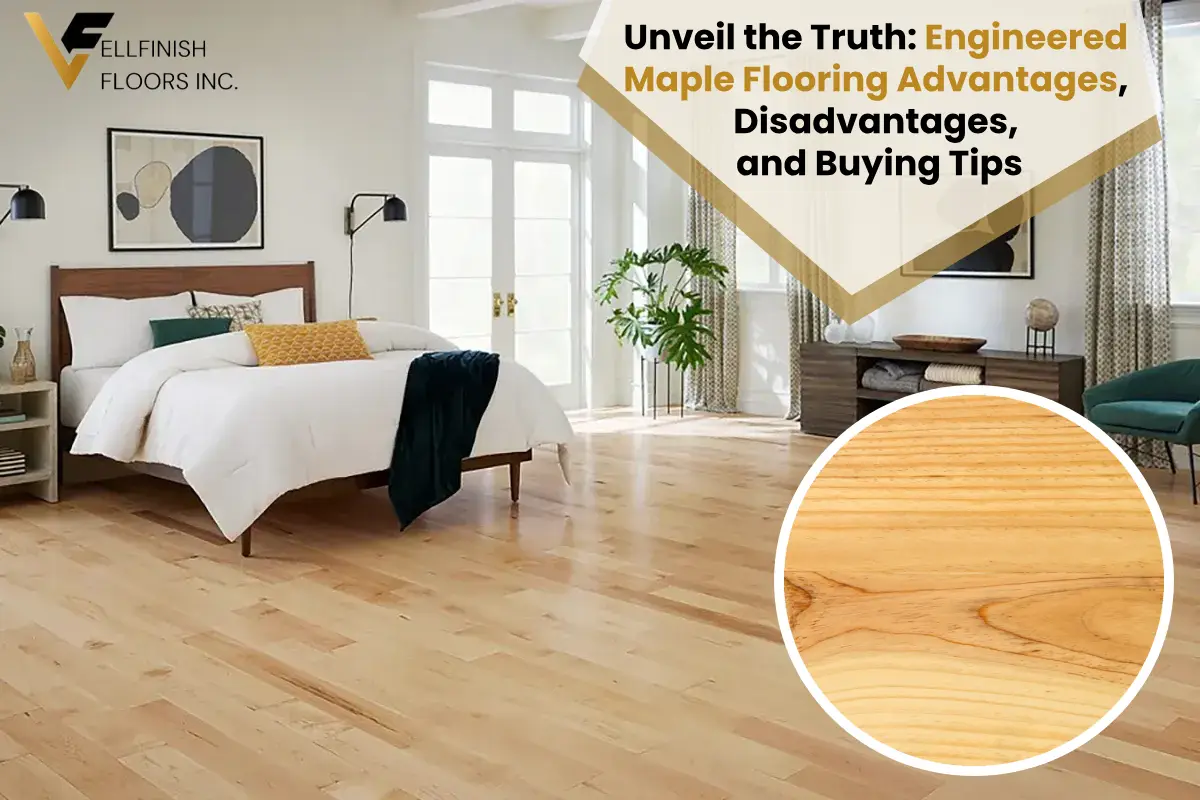Unveil the Truth: Engineered Maple Flooring Advantages, Disadvantages, and Buying Tips

When it comes to home renovation, there are few updates as impactful as new flooring. Of the numerous options on the table, engineered maple flooring has become a top choice for homeowners seeking hardwood looks without the disadvantages of conventional solid strips. Its combination of looks, durability, and functionality makes it attractive to all types of buyers—but as with any type of flooring, there are benefits and disadvantages.
This comprehensive guide will take you through the advantages, disadvantages, and must-know buyer tips of engineered maple flooring so that you can make an informed choice for your home.
What Is Engineered Maple Flooring?
Engineered maple flooring is a hardwood flooring product made of several layers. While solid maple is made of a single piece of wood, engineered maple is made of:
- Top Layer (Veneer): A thin cut of actual maple hardwood that gives the real look of maple grain.
- Core Layers: Multiple layers of plywood, fiberboard, or hardwood stacked in a cross-grain orientation for added strength and stability.
- Backing Layer: A stabilizing foundation that keeps the flooring from warping and remains durable.
This multi-layered construction enables engineered maple to better resist humidity and temperature changes compared to standard solid maple flooring.
The Pros of Engineered Maple Flooring
1. Maple’s Natural Beauty
Maple has a fine, smooth grain and creamy light tones. Engineered maple keeps this classic look, allowing your home to feel new, bright, and welcoming. It looks great with modern or traditional decors.
2. Strength and Durability
The engineered construction makes the maple less susceptible to warping, cupping, and shrinking than solid maple. It’s a great option for areas with changing climates or with residences that have changing humidity levels.
3. Versatile Installation Options
Engineered maple flooring can be installed in various ways:
- Glue-down
- Staple-down
- Floating installation (click-lock systems)
Its versatility even extends to installation above concrete slabs and radiant heating systems, a great option for basements, condos, or apartments.
4. Cost-Effective Alternative
Although still a high-end option, engineered maple tends to be priced lower than solid maple flooring. You’re getting the appearance and feel of real hardwood without the cost, so it’s a nice mid-price alternative.
5. Environmentally Friendly Option
Since engineered maple has a thin layer of hardwood on top of stacked cores, it needs less solid maple timber. This makes it more environmentally friendly than old-school solid hardwood planks.
6. Low Maintenance Requirements
Engineered maple has a high-quality finish that is less prone to scratches and stains compared to some softwoods. It will preserve its beauty for decades with proper maintenance without requiring rigorous upkeep.
7. Underfloor Heating Compatibility
Unlike solid hardwood floors, engineered maple can be installed over radiant heating installations without cracking or heat damage.
The Disadvantages of Engineered Maple Flooring
1. Limited Refinishing
The veneer at the top of engineered maple is thinner than that of solid maple. Depending on how thick it is (typically 1–4mm), you can only sand and refinish it once or twice during its lifetime.
2. Risk of Lower-Quality Products
Not all engineered maple flooring is equal. Lower-quality products might contain weak core materials, incredibly thin veneers, or inferior adhesives that wear out quickly. Buyers must thoroughly screen manufacturers.
3. Shorter Longevity Than Solid Hardwood
Though sturdy, engineered maple is not as long-lasting as solid maple floors, which can be refinished several times and typically endure for a century or more. Engineered flooring generally lasts 20–40 years.
4. Moisture Resistance Is Limited
Although more stable than solid maple, engineered maple is not waterproof. Standing water or prolonged exposure to moisture can lead to swelling, delamination, or damage over time.
5. Surface Hardness of Maple
Maple itself is harder than some woods, but it is prone to showing scratches and dents. Households with pets, kids, or heavy furniture should take precautions like area rugs or felt pads under furniture legs.
6. Price Variation
Engineered maple flooring spans a wide price range. Premium options can be almost as expensive as solid hardwood, while cheap options may lack the durability and lifespan you’re seeking.
Most Important Buyer Tips for Selecting Engineered Maple Flooring
1. Inspect Veneer Thickness
The thickness of the surface maple veneer will dictate how long the flooring will last and how often it can be refinished. For durability, seek a veneer that’s 3mm or more thick.
2. Assess Core Construction
High-grade engineered maple employs several layers of cross-ply hardwood or plywood cores. Steer away from products containing fiberboard or low-grade fillers, which are less stable and more prone to wear.
3. Know Finish Choices
Engineered maple is available with many finishes:
- Glossy: Shiny and sophisticated but has a tendency to show scratches.
- Matte or Satin: Resembles “worn-in” appearance and is easy to forgive with families that have children or pets.
- UV-Cured or Aluminum Oxide Finish: Provides best scratch and fading protection.
4. Balance Flooring with Lifestyle
If you have children or a high-activity household, select engineered maple with a thicker veneer, scratch-resistant coating, and matte finish. If you like a polished, high-gloss look and have lighter activity, glossy might be the way to go.
5. Method of Installation Is Important
- Try floating installation for DIY or temporary installations.
- Select glue-down or staple-down for heavier use areas or for permanent flooring.
- Always adhere to manufacturer instructions for subflooring preparation.
6. Read Warranties
A strong warranty signals product confidence. Look for warranties covering at least 25 years for residential use. Some premium brands even offer lifetime coverage.
7. Consider Maple Color Variations
Maple can range from pale cream to golden hues, sometimes with subtle reddish undertones. Be sure to check several planks before purchase to ensure the variation matches your home’s aesthetic.
8. Ask About Indoor Air Quality Certifications
Ensure your engineered maple flooring is certified for low VOC (volatile organic compound) emissions. Look for FloorScore or GREENGUARD certifications for healthier indoor air.
9. Professional vs. DIY Installation
Engineered maple is easier to install than solid hardwood, especially with click-lock systems. However, for glue-down or staple-down installations, hiring a professional ensures better long-term performance.
10. Budget Beyond Materials
Don’t omit underlayment, trim, baseboards, and installation expenses when planning for engineered maple flooring.
Care and Maintenance Tips
Engineered maple flooring, being strong, is well-served by regular maintenance:
- Regular Cleaning: Sweep or vacuum often to prevent dirt and grit scratches.
- Damp Mopping: Clean with a damp (not soaking wet) mop and a hardwood-safe cleaner. Use sparingly water.
- Shield from Sunlight: Extended UV light exposure can cause maple to bleach. Utilize curtains, blinds, or area rugs in sunlit areas.
- Avoid Scratches: Place felt pads under furniture and do not drag heavy items.
- Regulate Humidity: Maintain indoor humidity at 35–55% to avoid expansion and contraction.
Who Is Suitable for Engineered Maple Flooring?
Engineered maple flooring is the perfect choice for:
- Homeowners seeking the sophistication of maple without breaking the bank.
- Individuals residing in climates with varying humidity levels.
- Families looking for a resilient yet fashionable choice for living rooms, bedrooms, and even finished basements.
- Condo and apartment owners requiring floors perfect for installation over concrete or radiant heat.
Final Thoughts
Engineered maple flooring blends the classic beauty of maple wood with up-to-date technology that boosts its strength and flexibility. Though it is not as durable as solid maple, its cost-effectiveness, versatility, and beauty make it a shrewd investment for most homeowners.
By learning its advantages, disadvantages, and purchasing recommendations, you can choose engineered maple flooring that harmonizes style, functionality, and affordability. Whether your goal is to refurbish one room or revamp your entire house, engineered maple is a floor solution that’s as lovely as it is practical.


